Emergence of new dynasties
- Books Name
- Social Science Book
- Publication
- Cognizance Publication
- Course
- CBSE Class 7
- Subject
- Social Science
Chapter 2
New Kings and kingdoms
The emergence of new dynasties
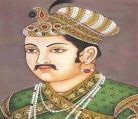
Many new dynasties emerged in different parts of the subcontinent between the 7th and 12th centuries.The 7th century there Big landlords or warrior chiefs in different regions of the subcontinent. Existing Kings often acknowledged them as their subordinates or samantas.As samanta gained power and wealth. They declared themselves to be maha-samanta, mahamandleshwar(the great lord of a “circle” or region)
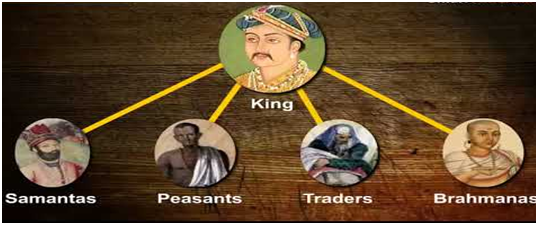
The Rashtrakutas
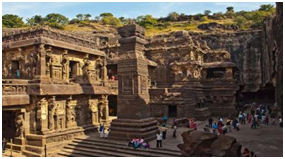
The Rashtrakutas in the Deccan were subordinates to the Chalukyas of Karnataka.In the mid 8th century, Dantidurga, Rashtrakuta chief overthrew chalukya overlord and performed the ritual called Hiranya Garbha.Literally the golden womb.When this ritual was performed with the help of Brahman, as it was thought to lead to the rebirth of the sacrifice or as a kshatriya, even if he was not one by birth.Gujarat Pratihara Harichandra and Kadamba Mayurasharmanwere Brahmanas successfully established kingdoms in Karnataka and Rajasthan respectively.Many of these new Kings have shared power with their Samantha's as well as with association of presents traders and Brahmanas.
Many of these new kings adopted high sounding titles such as Maharaja-adhiraaj(great King, overlord of Kings)tribhuvana-chakravartin and so on. Revenue in the form of land rent was collected from peasants cattle-keepers and artisans. In each of the states, resources were obtained from the producers.Who were often persuaded or compelled to surrender part of what they produced.These resources were used to finance the King's establishment as well As for construction of temples and forts.They were also used to fight wars which were intern expected to lead to the acquisition of wealth in the form of blunder and access tool and as well as trade routes.
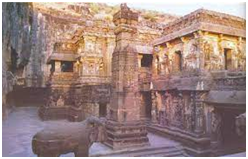
The Chalukyas
- The Chalukya dynasty was a Classical Indian dynasty that ruled large parts of southern and central India between the 6th and the 12th centuries. During this period, they ruled as three related yet individual dynasties.
- Badami Chalukyas: The earliest Chalukyas with their capital at Badami (Vatapi) in Karnataka. They ruled from mid-6th They declined after the death of their greatest king, Pulakesin II in 642 AD.
- Eastern Chalukyas: Emerged after the death of Pulakesin II in Eastern Deccan with capital at Vengi. They ruled till the 11th century.
- Western Chalukyas: Descendants of the Badami Chalukyas, they emerged in the late 10th century and ruled from Kalyani (modern-day Basavakanlyan).
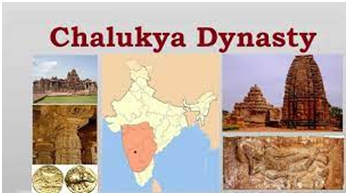
The Chalukya dynasty reached its peak during the reign of Pulakesin II.His grandfather Pulakesin I had created an empire around Vatapi.He also succeeded in getting a submission from the Chola, Chera and Pandya kings.He had also defeated King Harsha of Kannauj and the Pallava king Mahendravarman.
Administration in kingdom, Taxes and Land grants
Prashasti and land grants
Prashasti depicted the image that the king wish to project about themselves.They were composed by learnt Brahmans who are rewarded by grants of land.
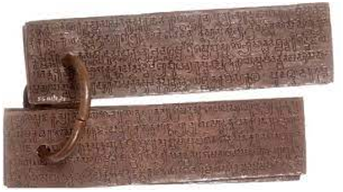
Unusual for the 12th century was a long Sanskrit poem containing the history of kings who ruled over Kashmir. It was composed by an author named Kalhana.Who was often critical about rulers and their policies, unlike other writers. He used a variety of sources, including inscriptions, documents, witness accounts and earlier histories to write his account.
Warfare for wealth
- Books Name
- Social Science Book
- Publication
- Cognizance Publication
- Course
- CBSE Class 7
- Subject
- Social Science
Warfare for wealth
Tripartite struggle
The city in the Ganga valley was an important city of that time.For centuries, rulers belonging to the Gurjar Pratihara, Rashtrakutas and Pala dynasty fought for control over areas.Because there were 3 parties in the long drawn conflict, historians describe it as the tripartite struggle.
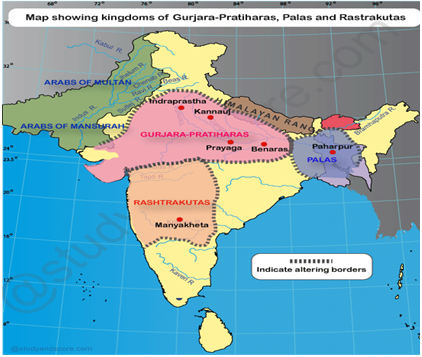
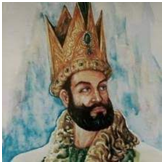
Sultan Mahmud of Ghazni from Afghanistan ruled from 997 to 1030.He raided the subcontinent almost every year and targeted wealthy temples including Somnath in Gujarat.Much of the wealth Mahmood carried away was used to create a splendid capital city of Ghazni.
Sultans
Chahamanas or the chauhans
The chahamanas or the chauhans,who ruled around Delhi and Ajmer attempted to expand their control to the West and the east.Where they were opposed by the Chalukyas of Gujarat and Gahadavalas of western Uttar Pradesh.The best known Chahamanas ruler was Prithviraj III (1168-1192) who defeated an Afghan ruler name Sultan Muhammad Gauri In 1191.
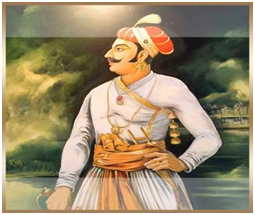
The Cholas
Cholas were from a small family of ‘uraiyar’. The successor of Vijayalaya conquered neighbouring regions such as the Pandian and Pallava territories to South and north, the most powerful Chola ruler was Rajaraja I.To reorganise the administration of the empire, Rajaraja’s son Rajendra I continued his policies.
Architecture
- Books Name
- Social Science Book
- Publication
- Cognizance Publication
- Course
- CBSE Class 7
- Subject
- Social Science
Architecture
Splendid Temples and Sculpture
Dravidian features initiated by the Pallavas acquired the classical forms and features under the Cholas such as gopurams, mandapams and vimanas. In the beginning gopuram features were subdued and Vimana features dominated but in the later stages, gopuram overshadowed the Vimanas. In the begining, Vimanas were constructed under the cellular mode as in the Raja Rajeshwar temple ( Brihadeeswara temple) at Tanjore where in the Vimana, various storeys were constructed in a graded manner. It has 13 storeys. In the later phase, vimanas began to be constructed in circular concept as in the Nataraj temple at Chidambaram. The Brihadeeswara temple in Tanjore is surrounded by a rectangular wall protected by 8 vimanas which hosed the 8 keepers of directions called Ashtadikpalas. The temple is dedicated to Lord Shiva and is known as Dakshimeruvitankar. An enormus Nandi which is the second largest in India, carved out of a single block of granite guards the entrance of the sanctuary. The Brihadeeswara temple is tallest of all the temples in India in the medieval period.
Rajendra Chola-1 constructed a city , a water tank and a temple with the same name of Gangaikonda CholapuramTemple.These big temples of Thanjavur and Gangaikonda Cholapuram, built by Raja Raja and Rajendra are sculptural and architectural marvels. Not only places of worship, they were the hub of economic, social and cultural life as well.Amongst the crafts associated with the temples, the making of bronze images was the most distinctive.Chola bronze images are considered among the finest in the world. Lord Shiva In cosmic dance form with celestial dancers is also found on the walls ofGangaikondacholapuram temple.
Bronze images of Nataraja (the dancing Shiva) are described as the cultural epitome of Chola period and are the best specimen of Chola art. Various plays were enacted in the premises of the temples for the sake of entertainment of the people.
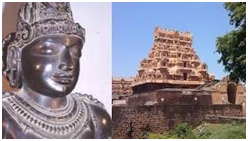
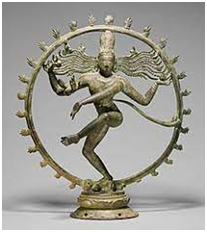
Social life
- Books Name
- Social Science Book
- Publication
- Cognizance Publication
- Course
- CBSE Class 7
- Subject
- Social Science
Social life
Agriculture and irrigation
The river Kaveri branches of into several small channels before draining into the Bay of Bengal.These channels overflow frequently, depositing fertile soil on their banks. Water from the channels also provided necessary moisture for agriculture, particularly the cultivation of rice.Forest were cleared and land was level for agriculture in many areas.In the Delta region, embankments has to be built to prevent flooding and canals has to be constructed to carry water to the fields.In many areas, 2 crops were grown in a year. During the rule of the Cholas, farmers were considered highly by the rulers and the society alike. At a time when farming was the main occupation of most people, farmers held some of the highest positions in society.
Agriculture and irrigation received good support from the Chola kings. Large number of wells were dug and tanks constructed to assist farmers. Stone dams were put up across rivers like Kaveri, to use water for agriculture. Channels carried water from such dams to distant farms.Artificial lakes were also common, which were fed by water from the rivers.
Money earned from trade was invested in agriculture.To support population,
the Cholas took extensive step for the expasion of agriculture.More land was levelled and forests were cleared for growing crops.Land grants were given to encourage agriculture.They dug wells and constructed tanks to collect rainwater.
A well planned irrigation system was developed to bring more areas under cultivation.Rajendra chola built an artificial lake with a network of canals to supply water for irrigation.
Rulers of Delhi
- Books Name
- Social Science Book
- Publication
- Cognizance Publication
- Course
- CBSE Class 7
- Subject
- Social Science
Rulers of Delhi
Delhi first became the capital of a Kingdom under the Tamara Rajput, who were defeated by Chauhans of Ajmer. The transformation of Delhi into a capital that controlled vast areas of the subcontinent started with the foundation of Delhi Sultanate at the beginning of 13th century.
The Delhi Sultans:-
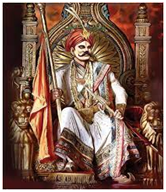
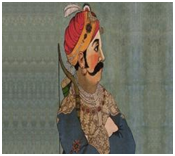
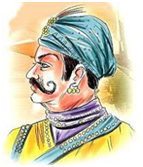
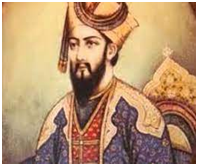
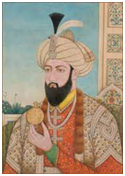
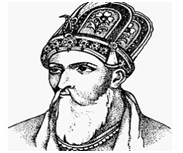
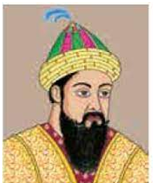
Indian architecture provide a lot of information. Further valuable sources are histories.Twarikh written in Persian language of administration under the Delhi Sultans. The author of Twarikh were secretaries, administrators, poets and courtiers, who both recounted events and advise rulers on governance, emphasizing the importance of just rule.
The authors of Twarikh lived in cities (mainly Delhi) and hardly ever in villages.They often wrote their histories for Sultan in the hope of rich rewards.These authors advice rulers on the need to preserve an ideal social order based on birthright and gender distinctions.Their ideas were not shared by everybody.
In 1236, SultanIltutmish’s daughter Razia Sultana inherited the throne. Since none of her brothers were qualified enough to become the king. However, this lead to lots of agony among the brothers, and the Queen was finally dethroned and killed in 1240.Whole idea of dethroning Razia Sultan was because the court and her brothers could not stand the women leading the empire and ordering the man of the court. Even Minaj- i-siraj felt that she was not supposed to be on the throne as women were made to be subordinate of men and that it does not qualify her to be one who should be ordering men, which led to her execution and the dethronement.
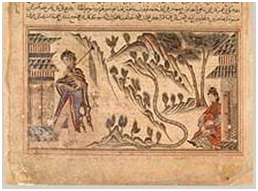
Expansion of sultanate
- Books Name
- Social Science Book
- Publication
- Cognizance Publication
- Course
- CBSE Class 7
- Subject
- Social Science
Expansion of Sultanate
From Garrison Town to empire, the expansion of the Delhi Sultanate
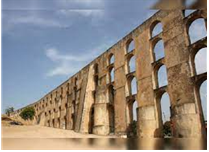
With the arrival of the Mongols and the Afghan invaders in the period of medieval history started. The invaders like Ghori never wanted to rule India, they just wanted to plunder the richest and use them for their lives in their own land. The period of Delhi Sultanate started in 1206 with the slave dynasty and Ibrahim Lodi became the last of the rulers in 1526.The Delhi Sultanate has been one of the most prominent ruling dynasties of Indian medieval history. Delhi has always been one of the most wanted region because of its central location and excellent connectivity. The popularity of the city grew in the 12th century and it became one of the most predominant centres of trade and culture.The city of Delhi gained popularity in 12th century.Under the tomaras and chauhans it grew as a popular centre of trade and commerce. The commercialization of the city leads to several Jainas moving to Delhi for business. Several Jain temples were constructed during this phase. Soon, Delhi emerged as the capital of Tamara Kingdom, which led to several rulers place in their eyes on the capital.
In the early 13th century, Delhi was just confined to fortified walls.The city heavily banked upon trade and trade was inturn dependent on trade routes. However, the trade routes often closed down due to bad weather.Under the reign of Gyassudin Balaban,the Mongols allmost overpowered the Delhi sultanate.However with Alauddin Khilji and the Muhammad Tughlaq taking over the throne,the Delhi sultanate was strengthened again.The two Kings successfully conquered neighbouring areas and cleared the Ganga, Yamuna doab and hunter gatherers and pastoralists expelled from their habitat.These lands were given to peasants and agriculture was encouraged. New fortresses, garrison town and towns were established to protect trade routes and to promote regional trade.The military frontier of the Delhi Sultanate then waged war against several arch-rivals and managed to win the battles, hence leading to the expansion of Delhi Sultanate.
The first set of campaigns along the ‘internal frontiers’ of the Sultanate aimed at consolidating the hinterlands of the Garrison towns. The second expansion occurs along the ‘external frontier’ of the sultanate.
The Masjid
A mosque is called Masjid in Arabic, a place where Muslim prostrates in reverence to Allah.Members of the congregation choose the most respected , learned male as the leader (Imam) for the rituals of prayer. He also delivered the sermon (kutba) during the prayer.During prayer Muslim stand facing Mecca.In India, this is to the West.This is called the qibla.The Delhi Sultans built several mosque in cities all over the subcontinent. These demonstrated there claims to be protectors of Islam and Muslims. Mosque also help to create the sense of community of believers who shared a belief system and a code of conduct. It was necessary to reinforce this idea of community because Muslims came from a variety of backgrounds.
Mosque of Jamali Kamali built in the late 1520s.Moth ki Masjid built in the reign of Sikandar Lodi by his minister. Begampur Mosque built in the reign of Muhammad Tughlaq, was the main mosque of Jahanpanah, “the Sanctuary of the world”,his new capital in Delhi.
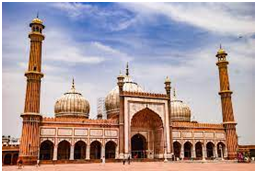
Administration kingdom, taxes and land grants
Administration of the empire
Settlement of peasants known as “ur”, became prosperous with the spread of irrigation culture.Group of such villages formed larger units called nadu.The village council and the nadu performed several administrative functions including dispensing, justice and collecting taxes.Rich land owners handled important offices of the state at the center.Grants of land were given to Brahmanas would looked after by an assembly or sub of prominent brahmanas and land holders. Brahmanas often received land grants, or brahmadeya.Each brahmadeya was looked after by an assembly or Sabha of prominent Brahmanalandholders.These assemblies work very efficiently. Their decisions were recorded in details, in inscriptions, often on the stone walls of temples.Association of traders known as Nagarams, is also occasionally performed administrative functions in towns.
The consolidation of Delhi Sultanate needed reliable governors and administrators. Iltutmish favoured their special slaves purchased for military service called ‘Bandagan’ in Persian. They were carefully trained to become most important political offices in the Kingdom. They were totally dependent upon their master,the Sultan could trust and rely upon them. The Khalji and Tughluqs continued to use Bandagan. Someone who is under the protection of another is called “Clients”. They were often raised to hi political positions. They were appointed as general and governors. Sultan Muhammad Tughlaq appointed a wine distiller, a barbar, acook, and two gardeners to high administrative posts.Ziauddin Barani was a Muslim political thinker of the Delhi Sultanate during Mohammed bin Tughlaq and Firuz Shah’s reign. The Khalji and Tughlaqmonarchs appointed military commanders as governors of territories. Lands were called ‘Iqta’ and their holders were called ‘iqtadar’ or ‘muqti’. The duty of the muqti was to lead military campaigns and maintain law and order in their iqta's. The muqti collected the revenues of their assignments as salary. They paid their soldiers from these revenues.The Sultan's administrators measure the land and kept careful accounts. Some of the old chieftains and landlords served the sultanate as revenue collector and accessors.Accountants were appointed by the state to check the amount of revenue collected by the muqti's.Care was taken that the muqti collected only the taxes prescribed by the state and that he kept the required number of soldiers. There were 3 types of taxes.
1.on cultivationcalled ‘kharaj’ and amounting to about 50% of the peasants produce.
2.on cattle and
3.on houses.
Ibne Batuta was a traveller from Morocco, Africa who visited in 14th century.
Mongols, Genghis Khan attacked on the Delhi Sultanate increased during the reign of Alauddin Khalji and in the early years of Muhammad Tughlaq’s rule.This force the two rulers to mobilise a large standing army in Delhi which posed a huge administrative challenge.
Sultans in 15th ,16th centuries
- Books Name
- Social Science Book
- Publication
- Cognizance Publication
- Course
- CBSE Class 7
- Subject
- Social Science
The sultanate in the 15th and 16th centuries
After the Tughluqs,the Sayyid ,the Lodi and the Suri dynasties ruled Delhi and Agra until 1526.By then Jaunpur, Bengal, Malwa,Gujarat, Rajasthan and the entire SouthIndia and new ruling groups such as the Afghans has independent ruler who has established flourishing states and prosperous capitals.
This was also the period which saw the emergence of new ruling groups like the Afghans and the Rajputs.Sher Shah Suri (1540-1545) started his career as the manager of a small territory for his uncle in Bihar and eventually challenged and defeated the Mughal Emperor Humayun(1530-1540, 1555-1556). Sher Shah Suri was the ruler and the founder of the Sur dynasty .He captured Delhi and ruled for 15 years. The best part is that he used alauddin’s plans and made them more efficient. He organized a long-lived bureaucracy responsible to the ruler and created a carefully calculated revenue system.
For the first time during the Islamic conquest the relationship between the people and the ruler was systematized, with little oppression and corruption. Sher Shah efficiently administered the army and tax collections, and built roads, rest houses, and wells for his people. He was generally tolerant of non-muslims, except in his massacre of Hindus after the surrender of raisen. His tomb at Sasaram is one of the most magnificent in India. Sher shah’s adminstration became the model followed by the great emperor Akbar when he consolidated the Mughal Empire. During Akbar’s rule, the Mughal empire tripled in size and wealth. He created a powerful military system too.
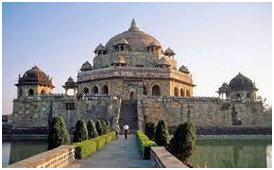

 Cognizance Publication
Cognizance Publication
